
Multi-Perspective Hand Reading: how does it work?
- Combining hand signs in multiple perspectives of the hand is an essential requirement for a solid assessment! -
Multi-Perspective Hand Reading represents a new concept in the field of hand reading. The key-element in Multi-Perspective Hand Reading involves the requirement to combine hand signs in different (multiple) levels of the hand. This requirement is necessary in order to arrive at a valid & reliable assessment for any of the major diagnostic themes in the fields of psychology, psychiatry & health!
Multi-Perspective Hand Reading was introduced in 2011 at this site. The concept has been derived from a wide range of research described in (academic) scientific publications.
The concept of Multi-Perspective Hand Reading implicates a REJECTION of the basic assumption made in folkloric hand reading (palmistry), because hand signs are typically inclined to bare significant value for MULTIPLE diagnostic themes. Multi-Perspective Hand Reading therefore points out that individual hand signs do not bare SPECIFIC diagnostic (nor predictive) value.
Therefore combining hand signs becomes sort of inevitable in order to arrive at a SPECIFIC assessment/diagnosis. An investigation involving many major diagnostic themes has unveiled that it is usually also necessary to combine hand signs in various dimensions (multiple-perspectives) of the hand.
The essence of Multi-Perspective Hand Reading can be understood with the principle that ANY individual hand sign can at best only serve as just a single 'building stone' towards building a proper & valid assessment.
In the new section Scientific Hand Charts (featuring 25 major diagnostic themes) this insightfull principle is summarized as follows:
"Any hand sign only bares significance for a specific theme when it's presence is combined with the presence of other hand signs that also bare significance for that same theme."

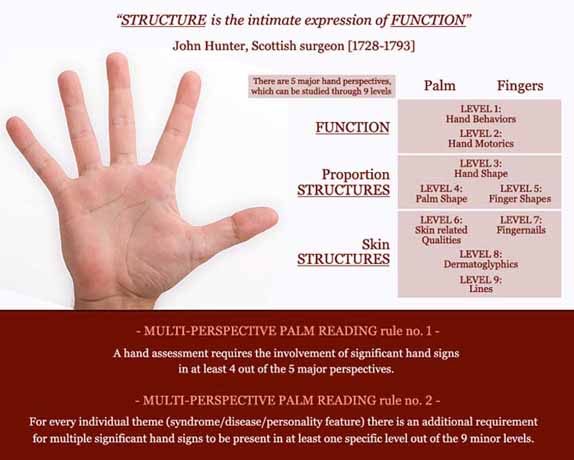
Multi-Perspective Hand Reading:
5 perspectives + 9 levels
In Multi-Perspective Hand Reading the hand is considered to represent a system involving 5 major perspectives + 9 hand levels (see picture).
In Multi-Perspective Hand Reading every single hand sign can be described/defined in terms of one single 'level' combined with two or three different 'perspectives'.
The 5 major perspectives in this system show 'structure' and 'function' to represent complementary phenomena; additionally, some of the 9 hand levels show a seperate role for the palm & the fingers.
The following quote serves as an illustration for this fundamental insight:
"Structure is the intimate expression of function"
John Hunter, Scottish surgeon (1728-1793)
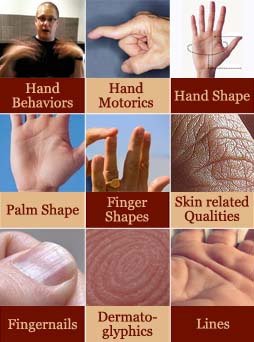

A classic example: the simian line!
In the perspective Multi-Perspective Hand Reading the simian line (a.k.a. single palmar crease) represent a classic example of a hand sign that has confirmed diagnostic value for a wide range of major diagnostic issues!
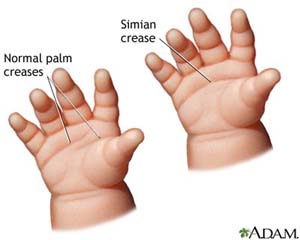
When taken in isolation, a simian line does not have any sort of specific meaning at all (be aware: there are estimates that almost a half billion people might have this hand sign in one or both hands). Nevertheless, when it is found in an individual combined with the presence of likewise significant hand signs for a specific diagnostic theme it does become signficant!
The most well known illustration for the simian line involves it's significance in Down syndrome (trisomy 21).
In the perspective of Multi-Perspective Hand Reading, a simian line combined with an axial triradius located near the center of the palm [both involve the perspectives: 'structure' & 'palm'] represent a combination that bares high significant for trisomy syndromes; however, Down syndrome is the only trisomy syndrome where the fingerprints show a dominance of loops [this involves the perspectives: 'structure' & 'fingers'] - see picture below.
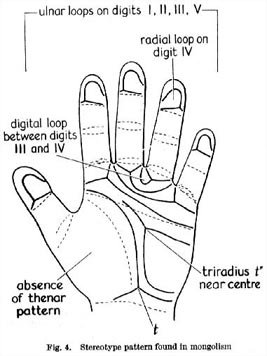
In a likewisely manner a simian line - combined with other hands signs - can represent a diagnostic marker for a wide range of other diagnostic health related themes, which can be understood in the perspective of the fact that in medical science a few decades ago the simian line became recognized to represent a 'minor physical anomaly' [MPA].
But even for some behavior- and psychology related matters the simian line might also bare significance, such as the Big Five personality dimensions & some major psychiatric problems!
A FINAL NOTIFICATION: All materials presented in the sections 'Major Diagnostic Themes' and 'Hand Sign Tutor' confirm the fundamental insight that became the building stone in the concept of Multi-Perspective Hand Reading.
On fundamental grounds one can safely REJECT the core principle used in 'classic palmistry', which suggests that individual hand signs are assumed to bare high significance. For, this core-palmistry principle sort of represents a philosophic building stone that has never been substantiated with empirical evidence (even though palmists might claim to have seen such evidence personally, this merely involves subjective anecdotal reports).
In the perspective of academic scientific research there is no confirming evidence available at all backing the assumption that individual hand signs bare SPECIFIC meaning. Reported results always indicate that high diagnostic signficance can only be acheived through the combination of hand signs. This implicates that whenever individual hand signs are being considered in isolation, they are UNLIKELY to bare high diagnostic significance (or predictive value). Scientific evidence always points out that only hand sign combinations are likely to bare signficance for practical purposes.
Technically, the psychological mechanism involved suggests that whenever anecdotal stories report high validity for individual hand signs, these reports are very likely the result of a proces involving a mix of subjective validation & selective perceptions - which can likely be attributed to the psychological mechanism known as the Forer-effect, a.k.a. the 'Barnum-effect'.
The words of American psychologist Ray Hyman (1977) illustrate how easily any palmist might become trapped into his- or her own assumptions & beliefs, especially when these are communicated with an attitude of confidence; Hyman described his no.1 rule (out of 13 rules) as follows:
'1. Remember that the key ingredient of a successful character reading is confidence. If you look and act as if you believe in what you are doing, you will be able to sell even a bad reading to most of your subjects. The laboratory studies support this rule. Many readings are accepted as accurate because the statements do fit most people. But even readings that would ordinarily be rejected as inaccurate will be accepted if the reader is viewed as a person with prestige or as someone who knows what he is doing.
One danger of playing the role of reader is that you will persuade yourself that you really are divining true character. This happened to me. I starred reading palms when I was in my teens as a way to supplement my income from doing magic and mental shows. When I started I did nor believe in palmistry. But I knew that to "sell" it I had to act as if I did. After a few years I became a firm believer in palmistry. One day the late Dr. Stanley Saks, who was a professional mentalist and a man I respected, tactfully suggested that it would make an interesting experiment if I deliberately gave readings opposite to what the lines indicated. I tried this out with a few clients. To my surprise and horror my readings were just as successful as ever. Ever since then I have been interested in the powerful forces that convince us, reader and client alike, that something is so when it really isn't.'
Hyman's experience illustrates the crucial need for the use of a control mechanism to do proper research in the fields of palmistry - in order to identify valid significance for any sort of hand sign.
The feedback of any single person taken in isolation may not serve this purpose at all.
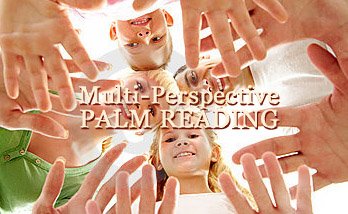
You might enjoy exploring more details about
Multi-Perspective Palm Reading:
The next major section presents for 34 conditions a summary of the most significant combinations involving 56 hand signs: